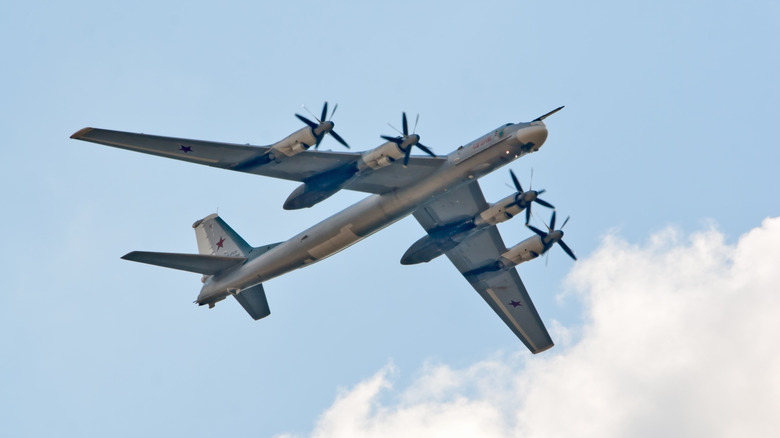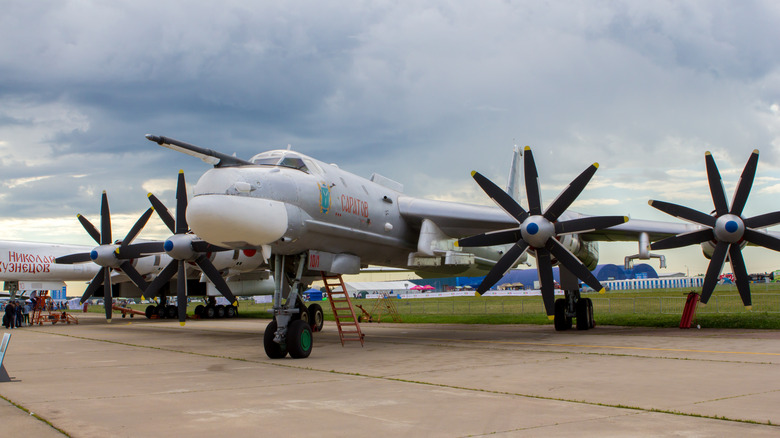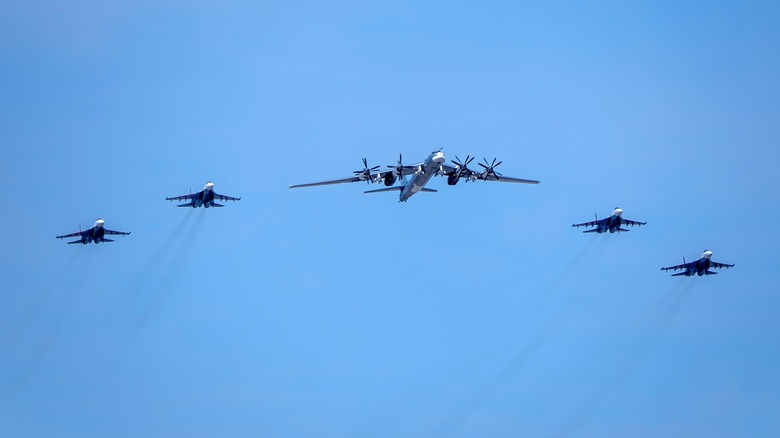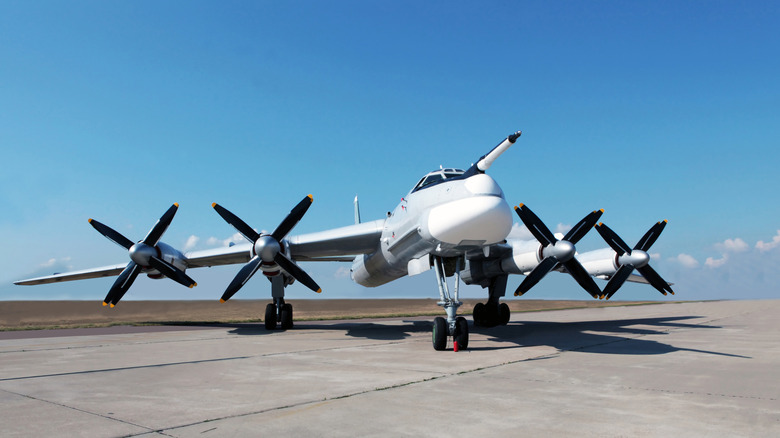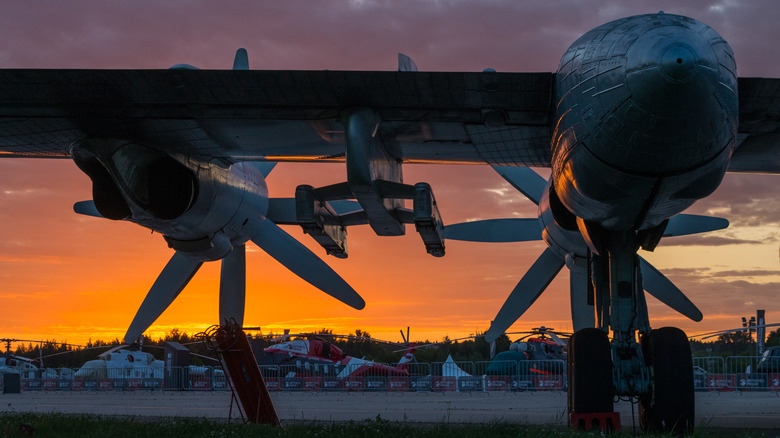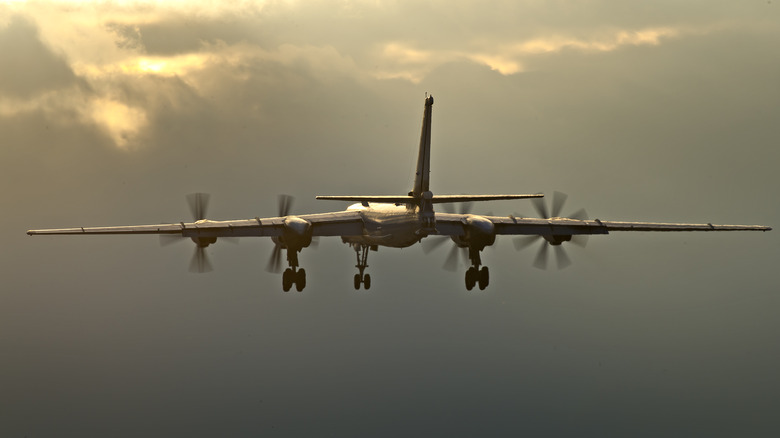The Biggest Strengths & Weaknesses Of The Tu-95 Strategic Bomber
The biggest rival to the United States for a time was the Soviet Union. Next to America, they had some of the most inventive ideas that put the two nations at odds on more than one occasion. This inventiveness eventually led to the development of one of the longest-serving aircraft in the world. The Tupolev Tu-95, dubbed the "Bear" by NATO, has soared through the skies since 1956. Starting production in 1952, roughly 500 bombers were created until production stopped in 1993. However, that hasn't stopped it from serving its country as it continues to patrol the skies.
Bombers face uphill battles when they're on an attack mission because of their speed and size compared to faster and more agile fighter jets. If bombers are detected on radar, it can be difficult to accomplish a bombing run. It doesn't help that something that's nearly 160 feet long with a wingspan that's just as large is hard to hide from radar. Old bombers, which the Tu-95 is, despite still flying for Russia, typically had a tail gunner to handle enemy aircraft. However, this monstrous airplane has several tricks up its sleeve that keep it on the active roster.
The Tu-95 had impressive range
The Soviet Union knew it wanted a bomber that could serve as a threat when it developed the Tu-95. That meant its engineers with the design bureau needed to create a large plane capable of intercontinental travel while carrying a hefty payload. What better model to use than Boeings' biggest achievement, the B-29 Superfortress. Of course, America wasn't willing to give the Soviets a chance, even if they were allies during WWII. As happenstance would have it, however, the Soviet Union got its opportunity in 1944 when a B-29 crashed in Soviet territory. The Tu-4 came out of everything the Soviets learned, and that eventually led to the Tu-95.
The Soviet Union ordered Andrei Tupolev, the director of the Tupolev Design Bureau, to develop the Tu-95 with a range of 4,970 miles before it needed to refuel. That gave it the ability to threaten key American targets and was only several hundred miles short of the B-29's max range of 5,300 miles. Today, thanks to modern technology, the Bear's max range has increased to over 7,000 miles. While it lives in the B-52 Stratofortress's shadow, a bomber with a range of 8,800 miles, the Russian bomber can now hit even more targets if it needs to. Its range is even farther than the modern-day B-2 Spirit stealth bomber, which can fly up to 6,000 nautical miles before it needs to refuel.
Stealth was never an option with the Tu-95
While the Bear does have an impressive range, part of that strength bleeds into its biggest weakness. The bomber is able to travel such a long distance because of its four Kuznetsov turboprop engines. Coupled with each engine are two four-blade counter-rotating propellors whose tips rotate faster than the speed of sound, making it one of the loudest planes in the world.
The amount of sound generated by the Tu-95 was so deafening that submerged submarines detected them whenever one was in the area. Stealth is a big factor for strategic bombing because if the enemy knows you're coming, it's easier to deploy one of the fastest fighter jets in the world to intercept and prevent the bombing from ever taking place.
Not only can enemies hear the Bear coming from miles away, but its radar signature is also quite large. After multiple encounters with the Tu-95 in the '80s around Alaska and Iceland, the United States and Canada installed an E-3 Airborne Warning and Control System (AWACS), eliminating the bomber's element of surprise completely.
An exceptionally long lifespan
There's no denying the Tu-95's impressive lifespan. It's a massive turboprop bomber that's been in service for over 70 years with no sign of being retired any time soon. Development of the massive bomber started back in the '40s, but the design went through a few iterations before arriving at the Tu-95. When the design bureau finally had the bomber they wanted, it officially entered service in 1956 and served after the fall of the Soviet Union in 1991. That wasn't the last the world would hear of the infamous bomber, though.
There was still a need for a strategic bomber that could reach key targets in the newly formed Russian Federation. The Tu-95 continued its service for Russia and went on to be fitted for a number of modifications and improvements. In fact, one of the most significant reasons it has remained in service is its adaptability. Because of its adaptability and reliability, Russia intends to keep the Tu-95 in service for nearly another two decades until 2040.
Just how adaptable was the Tu-95?
Russia's Tu-95 wasn't designed to carry just any kind of bombs. 1956 was right in the middle of the Cold War when the nuclear arms race was at an all-time high. Everyone was afraid of nuclear warfare dropping, and the Bear was one of the planes built to deliver a nuclear payload. In 1961, the Soviet Union built the largest thermonuclear bomb ever created. It was known as the Tsar Bomba and was capable of a 50-megaton blast, over 1,500 times stronger than the bombs used on Nagasaki and Hiroshima.
Weighing nearly 60,000 lbs. with a length of 26 feet and 6.9 feet in diameter, the standard version of the Tu-95 couldn't carry the Tsar Bomba and had to undergo a few modifications. The Soviets were ambitious, to say the least. Firstly, the Bear's engines needed an upgrade, followed by its bomb bay, suspension, and release mechanisms.
While initially designed to carry and deploy free-falling bombs, the Bear was eventually outfitted to launch cruise missiles. Depending on the type of missile, the Bear can carry anywhere between eight to 14 cruise missiles. With this armament, the bomber can test fighter-interceptor capabilities of hostile nations.
The Bear's defensive capabilities are lacking
Bombers from World War II were typically outfitted with a gunner seat in the tail to defend against enemy aircraft. Some had even more canons spread throughout the fuselage for better defense. The Bear only contains a single 23mm Autocannon located in the tail of the plane. It's a Gryazev-Shipunov GSh-23 and fires between 3,400 and 3,600 rounds every minute.
Unfortunately, a single turret in the tail of a plane isn't sufficient defense, especially when going against modern fighter jets like the F-22 or F-35. It might carry cruise missiles now, but those are long-range weapons not intended to be used against enemy aircraft. Not to mention the Tu-95 isn't a maneuverable aircraft that can survive a dogfight with a fighter jet. However, those cruise missiles are good for taking out stationary anti-aircraft weapons systems.
It doesn't help that the Bear isn't the fastest bomber in the sky. With a max speed of 515 mph, it's not outrunning any modern-day military jets. Its cousin, the Tu-160, which travels nearly two times faster than sound, is better suited for getting in and out of enemy territory quickly. Even compared to bombers like the B-52, it's considerably slower as the American bomber flies nearly 600 mph.
